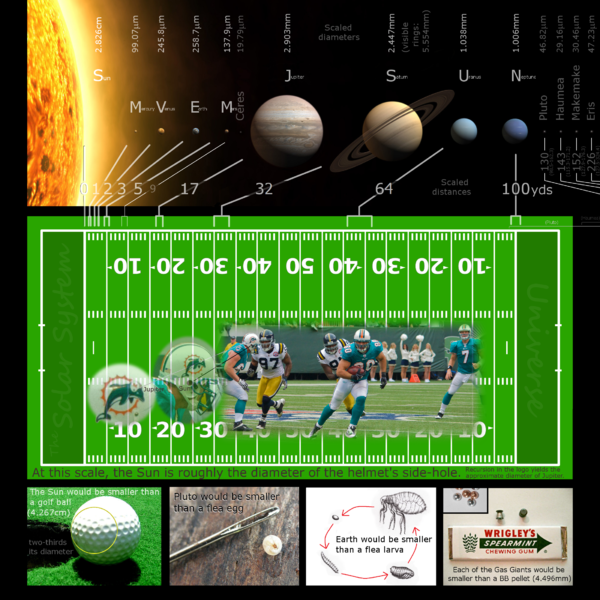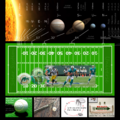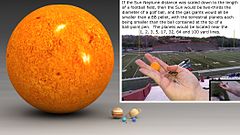File:Solar System scaled to a football field.png

Original file (2,200 × 2,200 pixels, file size: 3.3 MB, MIME type: image/png)
| This is a file from the Wikimedia Commons. Information from its description page there is shown below. Commons is a freely licensed media file repository. You can help. |
Summary
| DescriptionSolar System scaled to a football field.png |
English: The top section of this image shows the Solar System with its eight planets and its five known dwarf planets in relation to the Sun, with sizes drawn to scale.
In the middle section, the distance from the Sun to the farthest planet, Neptune, is scaled down to the length of an American football field with 100 yards from goal line to goal line (roughly 13 meters shorter than a standard soccer, or Association football field). All 14 objects are spotted at their scaled yardage along the gridiron, with pointers toward the location of Pluto and the other outer dwarf planets far off to the right of the field. The distances are labeled in whole yards, with brackets identifying the span of their elliptical orbits (Pluto's perihelion is shown to take it onto the playing field just inside of Neptune's orbit). At the top of the chart is a list of the diameters of each body as they would be found when shrunk down to this gridiron scale. The exact scale factor is 49,250,000,000-to-1. Precise numbers for the mean orbit distances of the planets as a percent of Neptune's mean distance are (Mercury through Neptune respectively): 1.287%, 2.402%, 3.323%, 5.063%, 17.292%, 31.712%, 63.786%, and 100%. The third section at the bottom relates commonly known objects to the scaled down sizes of the Sun and planetary bodies. With the most prominent being the Sun, it is shown to have a diameter smaller than a golf ball, by two-thirds at this scale (2.826cm versus 4.267cm). The gas giants are an order of magnitude lower, and terrestrial planets are an order of magnitude in size lower than that, and the dwarf planets one more order of magnitude lower still, generally speaking. The common object presented to reflect the size magnitude lower than the golf ball (/Sun) is the .177 caliber BB pellet. Four are pictured, as these are larger than all four gas giant planets at this scale. Further step-downs in magnitude are depicted in the life cycle of the common flea, in its cyclical stage from egg, to larva, to nymph, and then adult to lay eggs again. If a flea were to lay eggs on a football field, the diagram notes that the dwarf planets at the gridiron would be smaller than these eggs. The scaled-down Earth is smaller than the flea larva. An inset image in the lower middle section shows a play where the expanse of a gridiron can be seen. A pointer, along with a note, highlight the diameter of the Sun on the gridiron as being close to the same as an ear hole at the side of a player's helmet. The photo is from a Miami Dolphins' game, a team where the helmet is recursively shown in the logo. This scales down roughly one order of magnitude so that the ear hole on the mascot's helmet corresponds to the scaled down size of Jupiter. If the mascot were wearing a helmet with an identical logo, this would result in the phenomenon of infinite regression. The next level down would be a reduction of one more order of magnitude where the sizes of Earth and Venus would be depicted. One further level down would be three orders of magnitude below the diameter of the Sun and this is the size that represents dwarf planets. Galileo's first observations of Jupiter with a telescope revealed to him that the moons of Jupiter orbited around it. This was later understood as a "solar system within a solar system" - a recursion of the planets' motion around the Sun at a stepped-down magnitude of mass and size. The helmet size recursion in this image is an analogous mirroring of that quality that Galileo discovered in the Solar System. While the field itself may seem like vast emptiness, this only represents one section of the solar system as the planets orbit all the way around the Sun. And this representation of the ecliptic plane is only the one slice where such objects are found, while the entire three-dimensional volume includes the vast emptiness above and below this plane. The most distant probe ever sent from the Earth is Voyager 1. On Aug 25, 2012, at a distance of 121 AU, it's sensors detected a transition across the heliopause and it is now understood to be in interstellar space. At the scale of this image, that transition happened at a distance of 402 yards away from the Sun (another 3 football field lengths away). NOTES: The direction of lighting onto the planets is not accurately represented, as the Sun is diagrammed on the left. A total of eight Wikicommons images were combined to create this image, which was made using GIMP image editing software.
 File:SunMercuryVenusEarthMoon-Rockets full-court.png |
| Date | |
| Source | |
| Author | Tdadamemd |
| Other versions | Derivative works of this file: Solar System scaled to football field.png |
Licensing
- You are free:
- to share – to copy, distribute and transmit the work
- to remix – to adapt the work
- Under the following conditions:
- attribution – You must give appropriate credit, provide a link to the license, and indicate if changes were made. You may do so in any reasonable manner, but not in any way that suggests the licensor endorses you or your use.
- share alike – If you remix, transform, or build upon the material, you must distribute your contributions under the same or compatible license as the original.
Captions
Items portrayed in this file
depicts
7 May 2012
File history
Click on a date/time to view the file as it appeared at that time.
| Date/Time | Thumbnail | Dimensions | User | Comment | |
|---|---|---|---|---|---|
| current | 04:25, 22 March 2013 |  | 2,200 × 2,200 (3.3 MB) | Tdadamemd | Visually quantifying that the Sun scales down to two-thirds the diameter of a golf ball. |
| 03:28, 22 January 2013 |  | 2,200 × 2,200 (3.3 MB) | Tdadamemd | Increasing accuracy, to include changes to three yardage measurements that were not listed as the closest whole number rounding for average distance: Saturn, Uranus and Eris. Also indicating elliptical span for all bodies now, so Pluto's crossing of Ne... | |
| 03:10, 8 May 2012 |  | 2,200 × 2,200 (3.29 MB) | Tdadamemd |
File usage
The following page uses this file:
Metadata
This file contains additional information, probably added from the digital camera or scanner used to create or digitize it.
If the file has been modified from its original state, some details may not fully reflect the modified file.
| Horizontal resolution | 37.8 dpc |
|---|---|
| Vertical resolution | 37.8 dpc |
| File change date and time | 03:37, 22 March 2013 |

